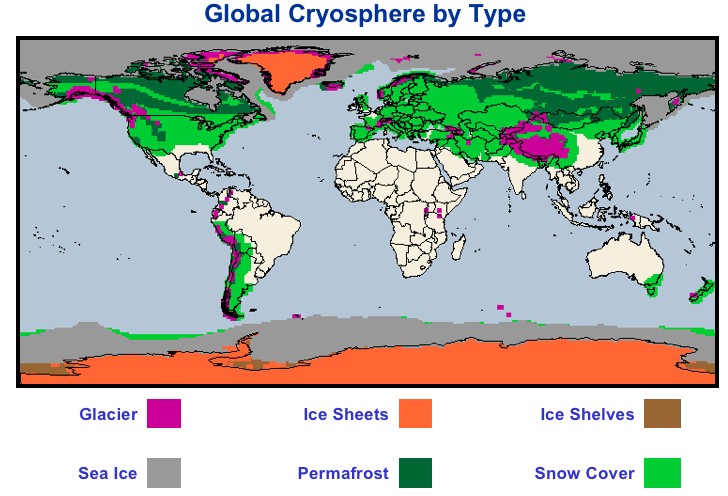About the Cryosphere |
|
The cryosphere1 is the part of the Earth system that includes solid precipitation, snow, sea ice, lake and river ice, icebergs, glaciers and ice caps, ice sheets and ice shelves, and permafrost and seasonally frozen ground2. The cryosphere is global, existing not just in the Arctic, Antarctic and mountain regions, but at all latitudes and in approximately one hundred countries. The cryosphere provides some of the most useful indicators of climate change, yet is one the most under-sampled domains of the Earth System. Improved cryospheric monitoring and integration of that monitoring is essential to fully assess, predict, and adapt to climate variability and change.
There are at least 30 cryospheric properties that, ideally, would be measured. Many are measured at the surface, but spatial coverage is generally poor. Some have been measured for many years from space; the capability to measure others with satellites is developing. The major cryosphere components and variables are:
- Solid Precipitation: rate, snowfall amount
- Snow: snow water equivalent (SWE), depth, extent, density, grain size, albedo
- Sea Ice: extent, concentration, type (age), thickness, motion, temperature, snow on ice
- Lake and River Ice: freezeup/breakup, thickness, snow on ice
- Glaciers, Ice Caps, Ice sheets, Ice Shelves, and Icebergs: mass balance (accumulation/ablation), thickness, area, length (geometry), firn temperature, velocity, snowline/equilibrium line, snow on ice
- Permafrost and Seasonally Frozen Ground: soil temperature/thermal state, active layer thickness, borehole temperature, extent, snow cover
These are defined in the Glossary.
 |
 |
1The word cryosphere is from the Greek kryos (κρύος), meaning cold, frost, or ice, and sphaira (σφαῖρα), meaning globe or ball (Henry George Liddell, Robert Scott, A Greek-English Lexicon, on Perseus).
2While components of the cryosphere are often defined to contain frozen water, permafrost may be "dry". The GCW definition includes components of the cryosphere that occur on or beneath the earth's surface, or that are measured at the surface in the case of solid precipitation. It therefore excludes ice clouds.



